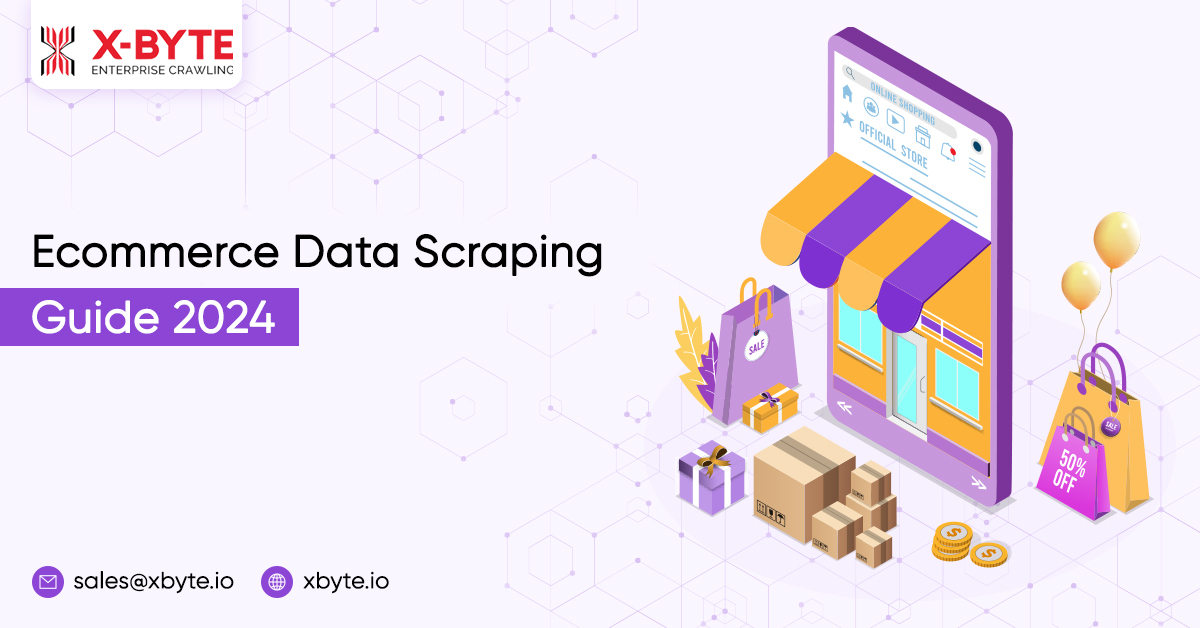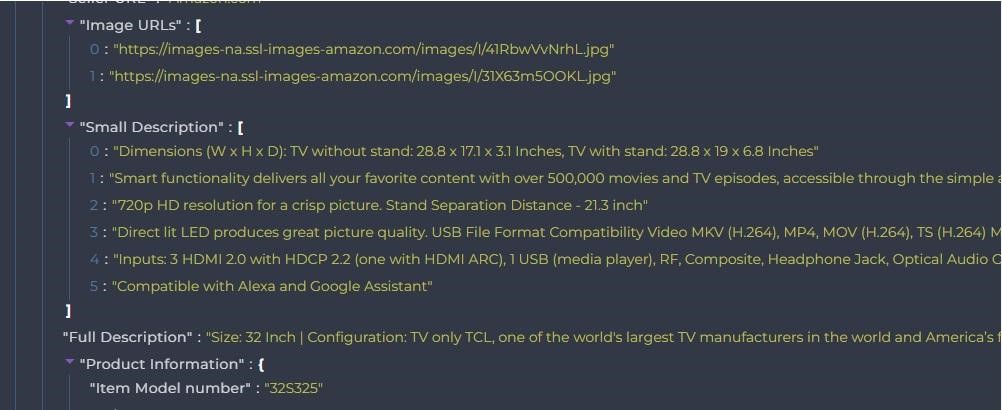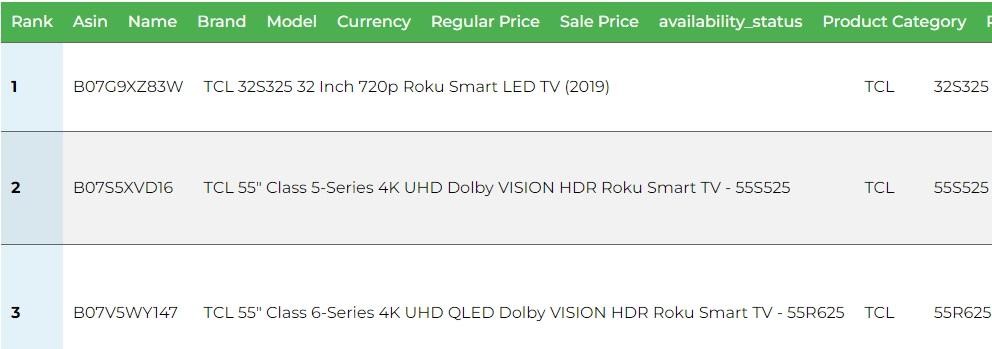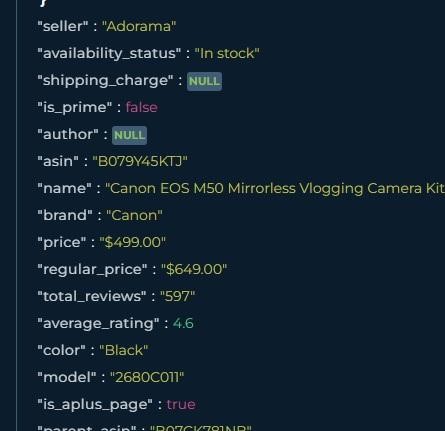
Table of Content
- What is Ecommerce Web Scraping?
- How Ecommerce Web Scraping Works?
- Ecommerce Web Data Scraping Benefits and Use Cases
- Top Challenges in Ecommerce Data Scraping
- Using X-Byte Web Scrapers to Scrape Ecommerce Websites
- Best Practices in Ecommerce Web Data Scraping
- Is Ecommerce Web Scraping Worth Your Money?
- Bottomline:
In 1979, when Michael Aldrich invented Electronic shopping, no one thought that it would be worth trillions of dollars in 2024. From its humble journey since then to its highly sophisticated e-marketplaces in the contemporary period, eCommerce has come a long way. Today there are a mammoth 26.5 million eCommerce websites globally with an estimated 6+ trillion US dollars in sales. The USA alone powers 14 million ecommerce stores. At first glance, the data is extremely pleasing when considering the prospects for ecommerce businesses, but it poses a rare challenge for new entrants in the field. How on earth are they going to compete with something on this scale?
Millions of similar products, thousands of similar SKUs, n+ number of competitive websites, deep-pocket e-commerce giants, and every day changing dynamics of the online marketplaces can be overwhelming for ecommerce businesses (both existing and aspiring ones).
But every dilemma has a solution. This is where ecommerce businesses need ‘data’. If they know what their competitors are selling, which products sell the most, how are they priced? What is the metadata on these products, and what level of ongoing interest is shown by shoppers on particular products? And finally, what are the reviews? With such data in hand, ecommerce businesses can develop their product positioning, pricing strategies, and online marketing for their products.
The best part is, that most data that ecommerce businesses will need is available online. They only need a method to extract the data. This is where ecommerce data scraping comes into the picture. Web scraping ecommerce websites helps ecommerce websites collect the required data that can be used for competitor analysis. Continuous web scraping uses a web scraping tool, predefined algorithms to scrape data, and a mechanism for tabulating data in structured form.
This guide details all aspects of ecommerce data scraping, its use, methods, tools, data touchpoints, and more. The guide also analyzes the key challenges faced in web scraping ecommerce websites and suggests their solutions. Finally, we have also explored the benefits of ethical and legal ecommerce data scraping.
Let us understand the world of ecommerce web scraping together:
What is Ecommerce Web Scraping?
E-commerce web scraping refers to the process of extracting data from e-commerce websites. This data can be either extracted via manual or automated processes (through bots called scrapers). Web scraping ecommerce websites extract info like product details, pricing, images, reviews, etc. from competitor websites. This data is analyzed to obtain relevant insights for optimizing one’s ecommerce website.
Manual web scraping involves a human manually copying and pasting data from web pages into a local file, like a spreadsheet, or using a programming language like Python for parsing websites. This process is incredibly time-consuming and prone to errors.
Automated web scraping uses bots to crawl through websites and extract data automatically. This process can handle large volumes of data and is significantly faster than manual scraping. Such services are provided by vendors in the form of APIs, Paid Scraping tools, or Scraping service providers whose in-house team does the scraping for you and provides you with the scraped data in a structured and tabulated form.
TouchPoints for Ecommerce Web Scraping: Scrapers can extract data from the below ecommerce touch points.
- Online Marketplaces like Amazon, Aliexpress, eBay
- Online retail websites
- Theme-based Experiential Stores
- Dropshipping Websites
Ecommerce Web Scraping is commonly used to extract the following types of data:
- Product Description: Provides in-depth knowledge about the product.
- Product Variants: Details different products (size, gender, size, season, usage, color, material, etc.)
- Technical Specifications: Outlines particulars like dimensions, technology, capacities
- Retail Price: Exhibits the regular price of the item.
- Warranty Information: Describes the warranty terms for the product, if any.
- Sale Price: Reveals any current discounts or promotional prices.
- Product Category: Defines the main category (Electronics)
- Sub-category: Defines the secondary category (Laptops)
- Brand: Collects brand info of sub-categories like (Dell, Asus, HP, etc.)
- Model: Collects Model info of brands like (Dell Vostro, HP Chromebook, etc.)
- Size: Collects size info of products (15.6-inch laptop, 14 Inch laptop)
- Related Categories: Linked categories or labels ( “Laptops”, related categories “Laptop Accessories”, “Software”, “External Storage”)
- Compatibility Information: Specifies what other products or systems the product is compatible with (For instance if a Tablet is compatible with Bluetooth Mouse/Keyboard)
- Return Policy: Provides details on the return policy.
- Materials: Lists the materials (for goods) the product is made of (100% cotton for clothing, Stainless steel for kitchenware)
- Availability Status: Signifies if the product is available or not (In Stock, Out of Stock, Pre-order)
- Product SKU: Displays the Stock Keeping Unit (SKU) number, a unique identifier for each product.
- Payment Options: Lists the payment methods accepted for purchasing the product (Cash on Delivery, Debit/Credit Card, EMI, Netbanking, UPI, Reward Points, Amazon Pay Later, etc.)
- Usage Instructions: guidelines on how to use a product (Charge for 2 hours before first use for electronics, do not wash in hot water for clothes, etc.)
- Safety Warnings: Highlights any safety precautions or warnings associated with the product. (For instance, not suitable for children under 3 years for toys)
- Primary Image: Serves as the main visual representation of the product.
- Inventory Quantity: Declares the quantity available, if specified.
- Reviews: Presents written reviews from customers.
- Ratings: Displays average scores and total review numbers.
- Vendor Identification: Names the seller or the producer.
- Seller’s Feedback Score: Demonstrates ratings or reviews specific to the vendor.
- Shipping Charges: Details of any related delivery costs. Example: “Free Shipping”, “$1.99 standard shipping”
- Delivery Regions: Identifies locales where delivery services (“Available in the US and Canada”, “Europe-wide delivery”)
- Delivery Timeline: Offers expected delivery schedules (Standard delivery, Express delivery, One-day delivery, two-day delivery, etc, 3-5 business days, etc. )
- Delivery Methods: Options for packaging (gift wrapping)
- Discount Codes: Provides information on applicable coupon codes
- Promotional Deals: Underlines exclusive, time-sensitive offers (Buy one, get one 50% off, Gift with purchase over $100)
How Ecommerce Web Scraping Works?
Ecommerce data scraping can be broken in the below steps:
Step 1: Send Request to Target URL
- Action: The first step involves the web scraper tool sending a request to the target website for the specific URL contents it aims to scrape.
- Response Format: Typically, the information from the website is returned to the scraper in HTML format.
Step 2: Load HTML Code
Once the initial request is made and the data is received, the entire HTML code for the page is loaded. This prepares the data for the next step of actual scraping.
Step 3: Select Specific Data for Extraction
In this step, the user decides what specific data they want to extract from the page. This could range from product details, prices, reviews, meta descriptions, etc. depending on the user’s needs.
Step 4: Extract Data
The scraper then extracts all the data available on the page or the specific data the user selects. This process involves parsing the HTML code to retrieve the relevant information. Web scrapers navigate the DOM of web pages to identify page structure. This helps to identify different elements on the e-commerce page, such as product names, descriptions, prices, images, and reviews.
Step 5: Output Data in a Useful Format
In the context of ecommerce web scraping, HTML parsing helps structure the extracted data in a readable and manageable format (e.g., tabular form, JSON) for further analysis or processing. CSV or Excel Spreadsheet is ideal for manual management or use within other programs. JSON is useful for more advanced applications, such as feeding data into an API.
Methods of Web Scraping Ecommerce Websites
| Methods | Pros | Cons |
|
Manual Scraping (Visiting websites and manually copying the needed data) |
● Simplicity: Requires no technical skills or special tools. ● Accuracy: Manual oversight can ensure high data quality. |
● Time-consuming: Impractical for large-scale operations. ● Costly: High labor costs and increased likelihood of human errors. ● Scalability: Not suitable for large-scale ecommerce businesses |
|
Developing Scrapers (Developing custom scrapers designed to extract data from specific websites) |
● Customization: Can be tailored to meet specific needs and handle complex website structures. ● Flexibility: Adaptable to changes in website layouts with updates. |
● Resource-intensive: Requires significant time and technical expertise. ● Maintenance: Needs regular updates to remain effective. |
|
Scraping Tools (Pre-built software or crawlers like Selenium or X-Byte Crawlers that automate the process of data extraction from ecommerce websites) |
● Ease of Use: Ready-to-use tools that require minimal technical knowledge. ● Efficiency: Quickly gathers data from predefined sources. |
● Limited Customization: Less flexible in handling unique or complex scraping needs. ● Dependence: Relies on the scraper’s ability to adapt to website changes. |
|
Scraping APIs (Scraping APIs can retrieve data, allowing users to make HTTP requests to get structured data directly from e-commerce websites) |
● Integration: Easily integrates with other applications for seamless data usage. ● Structured Data: Provides data in a ready-to-use format. |
● Limitations: Dependent on the availability and limitations of the API. ● Cost: Potentially high costs associated with API usage rates. |
|
Scraping Service Providers (Companies that offer web scraping as a service, handling the entire data extraction process for clients and delivering the data in a usable format) |
● Expertise: Leverages advanced technology and expertise. ● Convenience: Saves time and resources for businesses lacking in-house capabilities. ● Accuracy: Greater accuracy and quality of data |
● Cost: Can be expensive depending on the complexity of the requirements. ● Dependency: Timely deliveries depend on service provider quality |
Ecommerce Web Data Scraping Benefits and Use Cases
“Web scraping is one of the most powerful tools in a data enthusiast’s armory, like a digital miner who extracts precious information from the depths of the internet”
1. Ecommerce Price Comparison and Competitive Advantage
People go to fortune tellers who use crystal balls to predict the future. Web scraping is the crystal ball for ecommerce businesses. By gathering and analyzing the ecommerce data, web scraping lets ecommerce businesses predict the near future requirements for their businesses. From rethinking their product positioning to a sneak peek at competitors’ pricing, web scraping ecommerce websites can help you turn the wind in your favor with next-level ecommerce pricing intelligence.
2. Anticipating Market Demand
Suppose an ecommerce business finds that its competitor’s website or a big ecommerce platform like Amazon is increasing the stock quantity of a particular mobile model. This may be in anticipation of any subsequent brand buzz or promo that is going to be released. Only based on this data, the e-retailer can also predict the demand and stock up the stock adequately. However, this benefit can be availed of only if the ecommerce business is using a continuous web scraping tool or API.
3. SEO Improvements
By scraping your competitors’ websites, you can analyze the Meta titles, descriptions, features, product specifications, keywords, titles, shipping terms, product combos, alternatives, etc. they use for similar products. By making changes in your content and meta tags, you can improve search engine visibility. By analyzing the content and products that are currently popular on competitor sites, you can gather new ideas for your content strategy.
4. Keep Your Product Assortment Updated and Relevant
In ecommerce, trends are a defining factor that creates buying momentum. You can know the trends by tracking competitor products. This helps you keep your product assortment relevant, trendy, and aligned with what customers are looking to buy. Scraping data for analyzing product options and variants (like sizes, colors, brands, and materials) offered by competitors will help you keep your inventory competitive.
5. Analysis of Customer Reviews of Competitor Sellers to Know What Customers Want
Web scraping reviews from competitor ecommerce websites will help you determine which products, sellers, and brands are highly rated by customers. Analyze negative reviews to identify products that fail to meet customer preferences and satisfaction quotient. This will help you to avoid listing those products. With continuous or regular web scraping track changes in customer sentiment over time to stay in the loop.
6. Targeted Advertising
Utilizing IP-based web scraping tools, companies can gather detailed data on customer behavior, including search queries and location. The rich dataset supports the creation of highly targeted advertising campaigns specific to geographical areas and consumer preferences.
Top Challenges in Ecommerce Data Scraping
E-commerce data scraping involves confronting a series of challenges. Let’s explore these challenges and their plausible solutions:
Challenge 1: Diverse HTML Structures Across Websites
The scraper must be adaptable enough to understand and navigate through various HTML structures to extract the needed data.
Solution: Implement scraping tools that can adapt to different HTML structures. A web scraper that utilizes advanced parsing libraries for dealing with diverse HTML structures can help solve this challenge.
Challenge 2: Dynamic Product Listings
E-commerce sites keep updating their product listings with new items, discontinued products, price changes, and promotional offers. These frequent variations require scrapers to be extracting data at regular intervals.
Solution: Design scrapers that can automatically detect changes in product listings and adjust accordingly. This involves setting up scrapers to run at regular intervals to capture the most up-to-date information using dynamic scraping techniques.
Challenge 3: Layout Updates
E-stores undergo redesigns and layout updates to improve the user experience or refresh their appearance. New UI/UX trends also compel ecommerce websites to make layout/design changes. Such updates can alter the HTML structure, breaking the scraping scripts that were designed based on the previous layout.
Solution: You will need a scraper that quickly updates scraping scripts to match the new structure. Also, Implement automated monitoring with alerts when a website’s layout changes significantly.
Challenge 4: Blockages from Websites (IP Blacklisting)
Many websites (especially the highly sophisticated ones) detect and block automated access, including web scraping attempts. These websites have mechanisms to blacklist and block scraper’s IP addresses. This will prevent further access to the site.
Solution: Use advanced scraping techniques such as IP rotation, proxy servers, and more sophisticated methods like headless browsers to mimic human browsing patterns. For bigger websites use enterprise web scraping and scrape responsibly by adhering to a website’s robots.txt file and making requests at a reasonable rate.
Challenge 5: Retrieving Specific Data
Precise scraping is critical for collecting relevant data. Data analysis efforts are significantly reduced if only specific data is scraped for further analysis. However, considering the vastness of data on ecommerce sites, identifying and extracting the specific data can be challenging.
Solution: Employ precise targeting in your scraping scripts to ensure only relevant data is extracted. This can be done using advanced selection techniques within the scraping tools.
Using X-Byte Web Scrapers to Scrape Ecommerce Websites
E-commerce data extraction challenges mentioned above can be solved with advanced ecommerce web scraping by X-Byte.
X-Byte provides three ways to scrape ecommerce websites:
- Instant Data Scrapers by X-Byte
- Scraping APIs for Ecommerce Websites
- Custom Scraping Service for Ecommerce Websites
1. Instant Data Scrapers
How does it work?
Step 1: Input any search terms, for example, ‘Study Table’ or paste the URL of the Search Results to obtain all the product details from online retail websites like Amazon.
Step 2: Save the gathered data in your preferred format such as CSV, Excel, or JSON.

Or get data in Excel Sheet

Step 3: Set up the crawler to run at regular intervals – hourly, weekly, or daily, to receive the latest product updates on Dropbox.
2. Scraping APIs
Step 1: Using a code you can embed our API in your application. Codes are available for different Apps built on Python, Node, PHP, Java, and Ruby.
Step 2: Start getting data as the JSON response.

3. X-Byte’s Custom Scraping Service
Step 1: The first step involves understanding the specific data requirements of the client. This includes identifying the type of data needed, such as price, product information, reviews & ratings, top sellers, competitor data, etc. Based on the client’s needs, target platforms like Amazon, eBay, Costco, Etsy, BestBuy, Walmart, Shein, Target, and many others are identified for data extraction.
Step 2: The service is equipped to handle data crawling from nearly all types of websites, including eCommerce, Social Networks, News, Forums, Job Boards, and even those with Anti-Bot Measures and IP Blacklisting. Customizable options allow for the scheduling of scraping tasks.
Step 3: Utilizing advanced technologies, X-Byte ensures high-speed data crawling, enabling the collection of vast amounts of data in a shorter period. Automated checks to eliminate duplicate data and re-crawl invalid data. Machine Learning techniques are used to perform superior data validations.
Step 4: The extracted data is delivered to the client in their preferred format, ready for integration into their systems
Best Practices in Ecommerce Web Data Scraping
1. Addressing IP Blocking and Rate Limiting
- Dynamic IP Rotation: Advanced ecommerce scrapers like X-Byte integrate proxy management, which includes a pool of proxies to rotate IP addresses for each request. This dynamic IP rotation prevents websites from detecting abnormal numbers of requests from a single IP address, thus avoiding IP blocking.
- Geographic Distribution: These proxies are often geographically diverse, allowing requests to appear as coming from different locations around the world, further reducing the risk of detection and blocking.
- Rate Limit Adherence: Advanced ecommerce data scrapers (APIs or Web Scrapers) can intelligently manage request rates to adhere to the target website’s rate-limiting policies. By adjusting the frequency of requests to stay below the threshold, our scrapers ensure continuous access without triggering rate-limiting barriers.
2. Bypassing CAPTCHA Challenges
- CAPTCHA Solving Integration: Reliable web scrapers are equipped with a CAPTCHA-solving mechanism that can automatically detect and solve CAPTCHA challenges. This capability allows for uninterrupted scraping, even on sites that employ these anti-bot measures.
- Learning Algorithms: Advanced scrapers use AI and machine learning algorithms to recognize and solve CAPTCHAs with high accuracy, further improving the scraping process.
3. Headless Browsing and Automation Frameworks
- Simulating Human Interaction: By using headless browsers and automation frameworks, advanced ecommerce scrapers can mimic human browsing patterns, making detection more difficult. This includes actions like scrolling, clicking, and navigating through pages as a human would.
- Structured Data Extraction: The best web scrapers are designed to intelligently parse and extract data from complex web pages, transforming unstructured data into a structured format ready for analysis. This process ensures high-quality data output.
- Error Handling: Advanced ecommerce scraping tools like X-Byte are built to handle errors efficiently, including timeouts, server errors, and temporary blocks.
4. Adhering to Website Policies with Ethical Web Scraping
- Policy Compliance: Always review and adhere to the e-commerce website’s terms of service and legal policies. This compliance ensures your scraping activities are legally and ethically sound.
- Considerate Request Rate: To avoid overloading the site’s servers, it’s essential to manage the rate of your scraping requests. Utilizing smart throttling techniques can help maintain a balance, ensuring your activities do not negatively impact the website’s performance.
5. Ensuring Data Validation and Cleaning
- Data Validation: Employ data validation techniques to ensure the scraped data adheres to expected formats and value ranges. This step is crucial for maintaining the quality and reliability of your data.
- Data Cleaning Methods: Remove redundancies by implementing strong data cleaning methods. This eliminates duplicates and incorrect entries. Advanced ecommerce web scraping services provide a clean dataset that is significantly more valuable for analysis and accurate insights.
6. Handling Dynamic Content
- Dynamic Content Extraction: E-commerce websites often utilize AJAX or JavaScript for dynamic content loading. Ensure that your scraping methods are capable of interacting with these technologies to capture complete and accurate data.
- Automated interaction with sophisticated parsing: Web scrapers need to automate interactions with web pages, such as clicking buttons or scrolling, to ensure all dynamically loaded content is captured.
Is Ecommerce Web Scraping Worth Your Money?
Over 80% of Ecommerce companies use web scraping. Glean insights about pricing, product availability, consumer trends, and competitive strategies are extremely valuable for ecommerce businesses. When done correctly and responsibly, the investment in ecommerce web scraping can indeed be worth your money. However, invest in reliable ecommerce scraping tools or services that ensure the data collected is accurate and up-to-date. Ensure their scraping activities comply with legal regulations and respect website terms of service.
Bottomline:
The e-commerce marketplace revolves around customers and is a highly competitive field. Given the customer-centric nature of industries, conducting competitor analysis is not an option but a dire necessity. Web scraping or web data mining is a potent tool to harvest critical data from online stores. Ecommerce web scraping aids in monitoring prices, product research, comparing prices online, customer analysis, evaluating the online market, improving advertisements, and many more.
X-Byte Enterprise Crawling is one of the top ecommerce data scraping service providers that can serve the needs of any ecommerce business requiring quality data for competitor analysis. With multiple options for web scraping and custom data scraping solutions, X-Byte stands out as a reliable web scraping provider.
